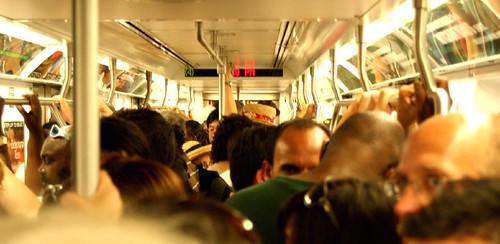The subways are crowded from any height. (Photo by flickr user allen81)
Subway riders, according to figures released by the Metropolitan Transportation Authority, is at a 56-year high. As anyone who ever rides the trains could tell you, the subways are indeed crowded.
The MTA’s own press release fills in the details:
The efficiency, value and convenience of MTA New York City Transit’s network of subways and buses drew 2.3 billion riders last year, the highest annual ridership since 1969 and an increase of 2.7 percent or 60.1 million trips over 2006. Over the past five years alone, NYC Transit’s annual ridership has increased 6.1 percent. On average, weekday ridership was a combined 7.4 million, a 2.1 percent gain over 2006. Weekend ridership – Saturday and Sunday combined – also showed impressive gains up to 7.7 million, the highest annual weekend ridership in more than 35 years…
Subway ridership of 1.56 billion accounted for more than two-thirds of NYC Transit’s ridership, and was the highest annual subway ridership since 1951. Subway ridership jumped 4.2 percent or 63.6 million trips from 2006. Weekday subway ridership in 2007 averaged more than 5 million, the first time it has done so since 1952. In 2007, average weekend subway ridership was 5.1 million, an increase of 6.3 percent or 304,000 trips from 2006 and the highest weekend ridership in over 35 years. Annual subway ridership increased 10.6% from 2002 to 2007.
The L train, serving rapidly gentrifying and expanding neighborhoods in Williamsburg and points east, saw the highest growth with an eight percent increase in passengers.
Meanwhile, the MTA used this announcement to highlight the need for adequate funding for the subway’s future. With annual ridership constantly increasing and showing no signs of slowing down, officials called for sufficient money for infrastructure. “The continued investment in new subway cars and buses is not going unnoticed by our customers who are responding by increased usage of our system,” MTA NYC Transit President Howard Roberts said. “These historic ridership gains do, however, point out the increasing need for additional funding for continued infrastructure upgrades.”
On the other hand, Gene Russianoff, lawyer at the Straphangers Campaign, noted that supply is not keeping up subway demand. “The good news is people are flocking to the subways. The troublesome news is they are not keeping up with enough service,” he said.
So there you go. If the subways seem crowded, it’s because they are. And if this sounds familiar, well, just check out the news from February about 2006.


4 comments
What the press release lacks is any indication of what the MTA intends to do about it. Service increases have been fairly modest (except on the L and 7 lines), and the capital projects are many years from providing any relief.
The MTA needs more of a vision than just a second avenue subway that’s 20 years from completion.
The MTA could of course put forward a new plan for adding 200 or 300 route kilometers to the system, like the Second System but adapted to the city’s current needs: SAS, outbound extensions in the Bronx and Queens, a direct line to Staten Island, a new trunk line in Queens. But there’s a good chance it’s going to evaporate as soon as the economy slowed down, just like all the other expansion plans.
Economic slowdown wasn’t the reason why the IND Second System was never built. There were three other reasons. The first was that the government decided to subsidize roads and bridges, rather than subways. The second was that Robert Moses monopolized every dime available, and ensured that mass transit was omitted from everything he built. The third was that Moses’ toll facilities generated surplus income that was plowed into more facilities of the same type.
By the time Moses’ policies began to fall into disfavor, the NYC Subway was already decades behind. Fares had been kept unrealistically low for too many years, leaving no funds for maintenance. No one could think seriously about expansion, when the subways we already had were in such poor shape.
Obviously the IND Second System wouldn’t have been built exactly as planned. Robert Moses didn’t get to build 100% of roads and bridges the way he planned them, either. But an awful lot of it would have been built.
Part of the problem today is that government doesn’t invest in infrastructure on the scale it did when Moses did most of his work. We’re in an era when people distrust government to do big things. Moses himself helped to create that distrust, though there are other reasons for it too, such as the modern influence of small-goverment Republicans both in Albany and in Washington.
One problem still hasn’t changed: unwillingness to charge the public fairly for the use of the transportation system. Spitzer’s recent insistence on keeping the base subway fare at $2 — which benefits only tourists and occasional riders — is typical. Resistance to Bloomberg’s congestion pricing proposal, which is itself only a bare shadow of what is really required, is another example.
[…] do we get out of this? What do we — the 2.3 billion of us who ride the subways — get out of this upcoming fare […]